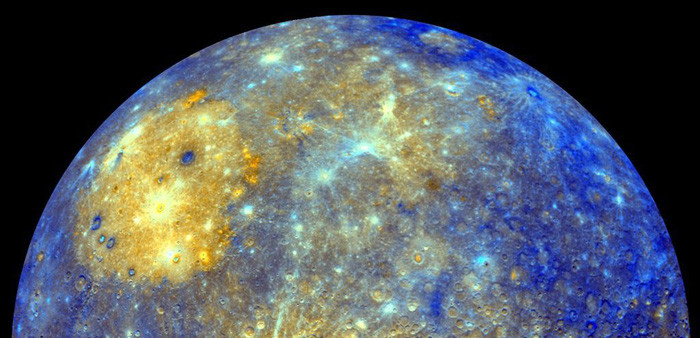Mysterious planet of the solar system
is the first planet from the sun, and the smallest of the 8 "brothers" in the Solar System. Behind this planet there are many interesting things that are being studied by the scientific world.
The most iron planet The solar system
Mercury is one of four planets made of Earth-like rock, and is also the smallest planet with a diameter of only 4,879.4 km.
This is equal to 0.383 times the Earth's diameter and is even smaller than the Ganymede satellite of Jupiter and Saturn's Titan satellite.
Iron accounts for a large amount in Mercury's structure. This is also the most iron planet in the Solar System.
Along with Venus, Mercury does not have natural satellites, while the remaining planets have orbiting satellites.
Day and night temperature amplitude is about 600 degrees Celsius

Atmosphere extremely thin Mercury - (Photo: NASA).
Mercury is also the closest solar planet to the eight planets, with a distance of about 57.91 million kilometers. This, along with a small volume, makes the atmosphere very thin, unable to retain heat.
Therefore, the thermal amplitude of day and night on Mercury is the largest in the Solar System, at night it can be down to -173 degrees C, but in the daytime it reaches 427 degrees C. Calculating the temperature amplitude fluctuating between day and night up to 600 degrees C.
Also because of the very thin atmosphere, Mercury does not have seasons in the year like the four seasons on Earth.
Mercury's orbit is an extremely narrow ellipse with a spindle radius of 70 million km, an auxiliary axis radius of only 46 million km. This is also a cause of great temperature difference for Mercury.
The day is two-thirds long

One year on Mercury is only 88 days on Earth - (Photo: NASA).
Mercury's rotation speed is very fast, about 88 Earth days. Meanwhile, Mercury needs about 58 Earth days to spin around the shaft.
Thus, one year in Mercury is too fast, only 88 days compared to 365 days on our planet and a terrible long day, equal to about 2 months of Earth.
In other words, a day of Mercury is about two-thirds a year long.
Surface like the moon

Mercury surface is like a moon - (Photo: NASA).
The surface of Mercury has many large and jagged holes like the surface of the moon. Most Mercury surfaces are covered with dry lava.
On the surface of this planet appeared many cracks, or giant cliffs stretching over a large area, looks like giant stairs. In particular, the largest rung is more than 1,000km long and 3km high.
Mercury has more volcanic craters on the surface than any other planet in the Solar System. The special thing is that most of these craters are named after famous writers and artists.
The "messenger god" of the Solar System

God Hermes in Greek mythology.
People know Mercury very early. 3,000 years BC, the Sumerians knew of Mercury's presence. Since Mercury is in Earth's orbit, when viewed from Earth, it can only be seen in the morning or evening, but cannot be seen at night.
The Romans took the name Mercurius (the Greek called the Hermes) - the god of communication and the myth in the myth, for Mercury. Perhaps because the Romans realized that Mercury's fast speed should be named like that.
Very difficult to "get used to"

completed the task in 2015 - (Photo: NASA).
Knowledge about Mercury is still limited due to difficulties in approaching this planet. Up to now, only two ships have been able to "glaze" to conquer Mercury: one was Mariner 10 in 1974-1975, two were Messenger launched into space on August 3, 2004.
As for Messenger, after arriving at Mercury orbit on March 17, 2011, the ship performed the task of observing, studying historical information, the geology of the planet is in the position closest to the sun.
Messenger flew 7.8 billion km over 6 years to reach Mercury and was the first space probe to penetrate Mercury's orbit.
Messenger flew around Mercury from 2011-2015 and sent back to Earth more than 280,000 images before ending the mission by crashing into the planet.
- NASA first admitted to having a strange planet hidden in the Solar System
- The 9th planet of the solar system is ... stolen goods?
- 99.99% has the 9th planet in the solar system
- Found a way to spot the 9th planet in the Solar System?
- 9th planet: 1 year long with 20,000 years Earth?
- Shocking theory: The mysterious 9th planet in the Solar System could be a black hole
- The mysterious X planet is devastating the solar system
- The 9th planet can be found in 16 months
- Evidence of the 9th planet of the Solar System
- Does the solar system have the 9th planet to own oceans and life?
- Explore the atmospheric atmospheres of the solar system
- The 9th planet can cause disaster for the solar system
 Van Allen's belt and evidence that the Apollo 11 mission to the Moon was myth
Van Allen's belt and evidence that the Apollo 11 mission to the Moon was myth The levels of civilization in the universe (Kardashev scale)
The levels of civilization in the universe (Kardashev scale) Today Mars, the sun and the Earth are aligned
Today Mars, the sun and the Earth are aligned The Amazon owner announced a secret plan to build a space base for thousands of people
The Amazon owner announced a secret plan to build a space base for thousands of people